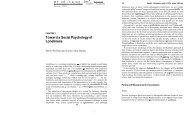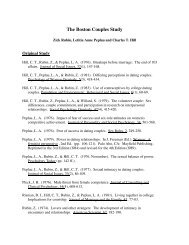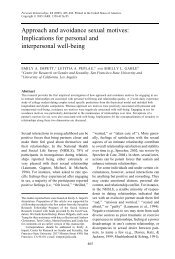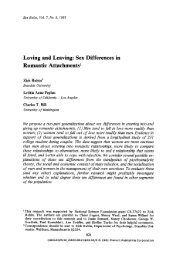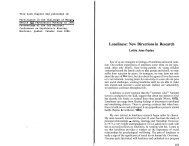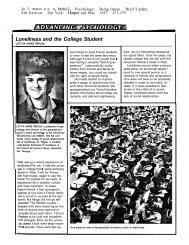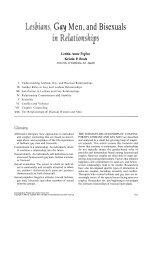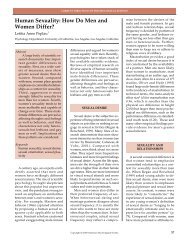"Exotic Becomes Erotic" Theory of Sexual Orientation - Anne Peplau ...
"Exotic Becomes Erotic" Theory of Sexual Orientation - Anne Peplau ...
"Exotic Becomes Erotic" Theory of Sexual Orientation - Anne Peplau ...
You also want an ePaper? Increase the reach of your titles
YUMPU automatically turns print PDFs into web optimized ePapers that Google loves.
392 THEORETICAL NOTES<br />
individual differences (besides IQ and sex itself) that so reliably<br />
and so strongly predict socially significant outcomes across the<br />
life span—and for both sexes, too. Surely it must be true" (p.<br />
323). Despite Bern's personal certainty about this issue, the<br />
research evidence suggests otherwise. Research on gender nonconformity<br />
documents many differences between the experiences<br />
<strong>of</strong> boys and girls.<br />
Retrospective reports. Most evidence about gender nonconformity<br />
and adult sexual orientation comes from retrospective<br />
studies asking adults to recall their childhood experiences. A<br />
recent meta-analysis <strong>of</strong> available retrospective studies (Bailey &<br />
Zucker, 1995) found a significant association between gender<br />
nonconformity and sexual orientation for both sexes. Importantly,<br />
memories <strong>of</strong> gender nonconformity were a much better<br />
predictor <strong>of</strong> homosexuality among men than women. Bailey<br />
(1996, p. 78) suggests: "Using results from our meta-analysis,<br />
we estimated that <strong>of</strong> girls as masculine as the typical prelesbian,<br />
only 6% will become lesbians. In contrast, the analogous estimate<br />
for feminine boys becoming gay men was 51%. Although<br />
these estimates are very rough, they demonstrate that [gender<br />
nonconformity] is substantially less predictive <strong>of</strong> homosexuality<br />
for females than males.''<br />
Prospective studies. Because memories <strong>of</strong> childhood may<br />
be colored by adult experiences, retrospective studies do not<br />
provide strong or conclusive evidence <strong>of</strong> causal processes. Longitudinal<br />
studies linking childhood gender conformity and adult<br />
sexual orientation would permit more solid conclusions. Several<br />
studies have followed boys initially referred to clinics because<br />
<strong>of</strong> gender identity disorders (see review by Zucker & Bradley,<br />
1995). For example, Green (1987) followed a sample <strong>of</strong>' 'feminine"<br />
and control boys from childhood to young adulthood,<br />
and found that more than three out <strong>of</strong> four "feminine" boys<br />
could later be classified as homosexual or bisexual. This is<br />
clearly a strong association, and other studies <strong>of</strong> clinic samples<br />
have replicated this finding for boys (see review by Zucker &<br />
Bradley, 1995). Of course, most gay men did not suffer from<br />
gender identity disorder in childhood and were not referred for<br />
treatment, so the extent to which research based on clinical<br />
samples is relevant to the experiences <strong>of</strong> most gay men is open<br />
to question.<br />
Prospective studies <strong>of</strong> gender nonconforming girls do not<br />
exist (Bailey, 1996, p. 77). The only available information is<br />
provided in case studies. In an ongoing prospective study <strong>of</strong><br />
children referred to a Toronto clinic for gender identity disorders<br />
(Zucker & Bradley, 1995, pp. 294-295), five girls initially<br />
seen in childhood for extreme masculine behavior were later<br />
reinterviewed in adolescence. Three <strong>of</strong> the adolescent girls reported<br />
exclusively heterosexual fantasies; <strong>of</strong> these, two had not<br />
yet engaged in sexual behavior and one was exclusively heterosexual.<br />
A fourth adolescent did not report sexual fantasies or<br />
behavior. A fifth adolescent girl "reported an exclusively heterosexual<br />
orientation in fantasy and in behavior; however, there<br />
was compelling evidence that she was in fact involved in an<br />
enduring lesbian relationship" (Zucker & Bradley, 1995, p.<br />
295). These data, though obviously limited, appear to be quite<br />
different from findings for boys, and do not indicate a link<br />
between childhood gender nonconformity and sexual orientation<br />
in adolescence for girls.<br />
The experience <strong>of</strong> gender nonconformity in childhood. A<br />
major reason for the weak and inconsistent association between<br />
gender nonconformity and adult sexual orientation for women<br />
is that tomboyism is widespread among American girls. For<br />
example, 51% <strong>of</strong> Midwestern women approached in a shopping<br />
mall indicated that they had been tomboys (Hyde, Rosenberg, &<br />
Behrman, 1977). In another study, designed to avoid retrospective<br />
bias, junior high students attending a church camp were<br />
asked if they considered themselves "tomboys" (Hyde et al.,<br />
1977). Sixty-eight percent <strong>of</strong> the girls reported that they were<br />
tomboys. In a recent study (Sandberg, Meyer-Bahlburg, Ehrhardt,<br />
& Yager, 1993), parents <strong>of</strong> 687 boys and girls ages 6 to<br />
10 rated how <strong>of</strong>ten their child engaged in a list <strong>of</strong> possible<br />
gender-typical and gender-atypical behaviors (e.g., "he dresses<br />
in male clothing" or "he plays with dolls"; "she experiments<br />
with cosmetics" or "she dislikes wearing attractive girl<br />
clothes"). Results indicated that 39% <strong>of</strong> girls and 23% <strong>of</strong> boys<br />
showed 10 or more different gender atypical behaviors at least<br />
occasionally.<br />
Social reactions to gender nonconforming boys and girls are<br />
<strong>of</strong>ten quite different (Martin, 1990; Zucker & Bradley, 1995;<br />
Zucker, Wilson-Smith, Kurita, & Stern, 1995). In the eyes <strong>of</strong><br />
many children and adults, a "sissy" is about the worst thing<br />
that a boy can be (Preston & Stanley, 1987). In contrast, most<br />
tomboys are accepted socially and even rewarded by peers and<br />
adults. For example, Hemmer and Kleiber (1981, p. 1210) studied<br />
fifth- and sixth-grade tomboys and found that they were<br />
"popular, cooperative, helpful, supportive <strong>of</strong> others . . . and<br />
were regarded as leaders." In other studies, girls who engage<br />
in cross-gender behaviors were just as popular as gender-conforming<br />
girls (Bemdt & Heller, 1986; Huston, 1983). In a recent<br />
study, fifth- and sixth-grade children watched a video <strong>of</strong> a child<br />
playing a gender-appropriate game with members <strong>of</strong> the same<br />
sex, or a gender-inappropriate game with members <strong>of</strong> the other<br />
sex (Lobel, Bempechat, Gerwitz, Shoken-Topaz, & Bushe,<br />
1993). Children rated the girl who played a masculine game<br />
with boys as the most popular and the boy who played a feminine<br />
game with girls as least popular. Parents and children alike<br />
tend to accept girls who exhibit traditional masculine play preferences<br />
or tomboy behaviors (Carter & McCloskey, 1983-<br />
1984; O'Leary & Donoghue, 1978).<br />
In short, gender nonconformity among girls is <strong>of</strong>ten socially<br />
acceptable. Although rejection and ostracism may occur in individual<br />
cases, they are not the common or modal social response<br />
to tomboyism in our culture. One reason for the social acceptance<br />
<strong>of</strong> tomboys may be that they tend to combine so-called<br />
masculine interests with more traditionally feminine interests.<br />
For example, a study <strong>of</strong> 210 fourth, sixth, eighth, and tenth<br />
graders and adults (Plumb & Cowan, 1984, p. 703) found that<br />
' 'self-defined tomboys do not reject traditionally feminine activities;<br />
instead, they expand their repertoire <strong>of</strong> activities to include<br />
both gender-traditional and non-traditional activities.'' Tomboys<br />
and gender-conforming girls did not differ in their preference<br />
for traditionally feminine activities (e.g., sewing, jumping rope)<br />
but did differ in their preference for masculine activities (e.g.,<br />
football, surfing). Another reason for the differential evaluation<br />
<strong>of</strong> tomboys and sissies may concern expectations about the future<br />
lives <strong>of</strong> these children. In one study (Martin, 1990), adults<br />
predicted that when "sissy" boys grew up, they would have<br />
poorer psychological adjustment than tomboys or gender con-



